Introduction – Display – Images – Also-rans – Lessons Learned – Assessment Criteria - Links
Introduction
On the face of it this is a very simple assignment – take a dozen photographs of a small area of land exhibiting as great a variety as possible of landscape imagery.
Living on the edge of the Lake District it would be relatively easy to find an acre that offered any permutation of mountains as a backdrop, lakes, waterfalls, woodland and meadows – perhaps even all of them. Too easy in fact – and too impersonal. Instead I have chosen a patch of land much closer to home – a small ‘nature area’ in the Community Gardens next to my home – a patch of land I regularly visit for a bit of peace and quiet, or to feel alone with the world.
It is almost exactly 1 acre, in a shallow valley surrounded by hedgerow on three sides and some recently developed wildflower areas on the other. It includes a large(-ish) and two small man-made ponds and after the rainy summer we have had is extremely wet underfoot. Vegetation is largely sedges, grass and the usual collection of nettles and thistles. It is visible as the left hand portion of the central field in the Google maps image below. A ground level panorama is attached in the Also-rans section.

This shot was taken sometime in late winter/early spring. The paths are not now overgrown and the small brown area to the right of my chosen ‘patch’ is grassy rather than bare earth. It was also taken a couple of years ago so that the ponds are no longer as clearly defined.
As patches of countryside go it is pretty unremarkable and that, to me, is its attraction. As we have become a more urban population we are led more and more to see the countryside as a spectacle – somewhere to go at the weekend – which means that we need to be entertained while we’re there. Visiting lakes, collecting Wainwrights, cruises, set viewpoints – all seem to me to be symptoms of a separation from the environment around us – and so I want, in this project, to capture something of the reality of my local countryside and why I find this piece of land worth visiting.
In doing this I have tried to build on a couple of the ideas and themes I started to explore in People and Place. In particular:
- using collage to construct a ‘place memory’ which I started in People and Place;
- exploring perspective away from the single viewpoint of a standard image; and,
- including a selection of night images to illustrate the difference in character that darkness induces.
Display
As suggested in the feedback for Assignment 1 I have given some thought to how I might choose to display these images. This has impacted on my choice of images in accordance with my aim to investigate perspective and space memory.
I have selected the images in section 1 to allow a wrap-around style of presentation on four sides of a square with the viewer in the middle. Completely enclosing the viewer in this way would increase the sense of being there and isolated from the world around in very practical way. Although I think it is outside the remit of this assignment I think such an approach would be complemented if the outside of each of the four “walls” was backed with an image taken facing in the direction of, and featuring, the photographer to give a physical impression of actually being present in the field
This idea was prompted by a number of images on the website of photographer Mikkel McAlinden – in particular those of the card players and arm wrestlers.
The artist David Hockney has done a lot of work exploring memory and perspective – his joiners are an example of multi-point perspective, and his recent multi-camera work attempts to produce a moving image which is more representative of the way we see. I made a simple exploration of this, and my understanding of the way memory works in my People and Place blog referenced above.
My intent with the images in section 2 is to build on this. I envisage the images being displayed as a single large collage (attached at the end of the image section) or as individual cropped and framed/mounted images either displayed flat on a wall or in a 3-D display with a slight vertical and horizontal curvature to allow a physical sense of surrounding.
By contrast with the simple black/orange monotone of my blog post this Assignment requires a greater diversity of images, introducing a broader range of colours and details that have to be selected and assembled to create that ‘place memory’. By displaying them as a large collage the eye is forced to move from place to place and assimilate different scenes and levels of detail so that the brain slowly builds a picture of the overall area in a process which is akin to the way I perceive my memory works.
Images
Section 1: At Night
For these shots I initially set my camera up with my back to these reeds. The 4th shot is deliberately a squarer format that the others so that when used as suggested below it would provide a sense of standing on the edge of an open area. The slight softness introduced by noise reduction mirrors the loss of detail in night viewing.
Figure 1: Night view looking west: Fig 1-3 all ISO 400, 30 secs @ f/8 and 14mm (28mm equiv)

Figure 2: Night view looking north
Figure 3: Night view looking east
Figure 4: Night view looking south: ISO 400, 20 secs @ f/8 and 14mm.
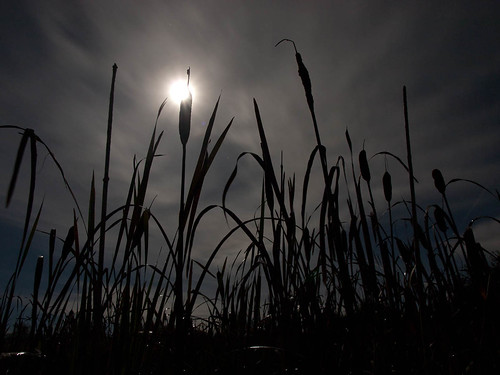
Section 2: Memory of Place
Figure 5: Blue Sky: The day of these shots there were some interesting high level clouds that I felt would make an inserting top to the collage: 1/400 @ f/8; ISO 200; 33mm. Slight overexposure to lighten cloud.

Figure 6: View over reeds to northern boundary. Taken from behind the reed beds in shot 4. Any attempt to capture this patch of ground needs to emphasise water and marsh so reeds and wetness are a central feature of the collage. 1/160 @ f8: ISO 200; 14mm
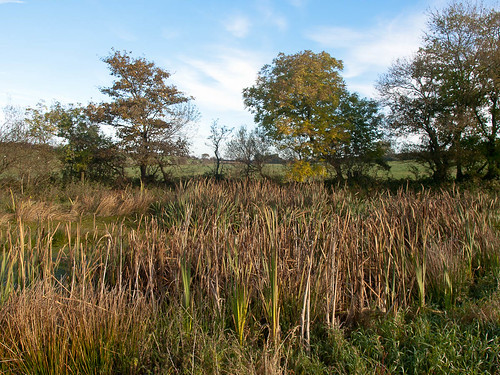
Figure 7: View to western boundary. Included to give and edge to the field in the collage. 1/1250 @ f/5: ISO 200; 23mm
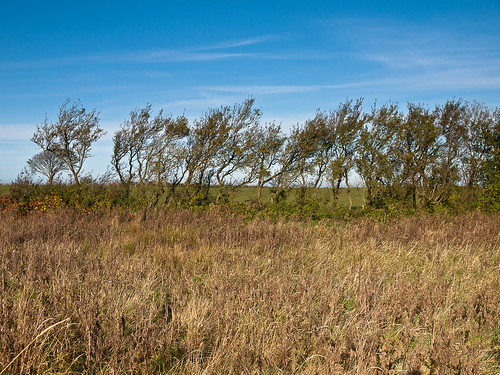
Figure 8: Dew on marsh plants. Again an attempt to add to the overall feeling of wetness, and to provide a nice damp base to the collage. 1/160 @ f/8; ISO200; 54mm. Slight underexposure to avoid burn out in droplets.
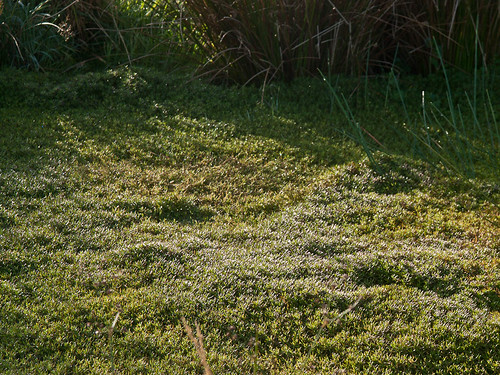
Figure 9: Partially submerged marsh plants. These are actually the same plants as the previous shot, but taken after a spell of prolonged rain a few days later. The reflection of the sky helps to link the various parts of the collage together. The ponds are central to the area and this shot is central to the collage. 1/8 @ f/16; ISO 100: 50mm. 1 stop overexposed to brighten clouds.

Figure 10: Backlit reed and sedges. I felt that a vertical crop of this image would make a good edge shot and the backlighting would add to the variety. 1/100 @ f/9; ISO 100; 50mm
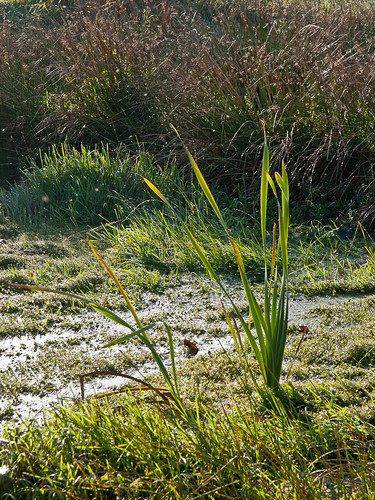
Figure 11: Autumn leaf. A close up for variety and to establish the season. 1/1000 @ f/5: ISO200: 54mm. Slight underexposure to retain detail in the leaves
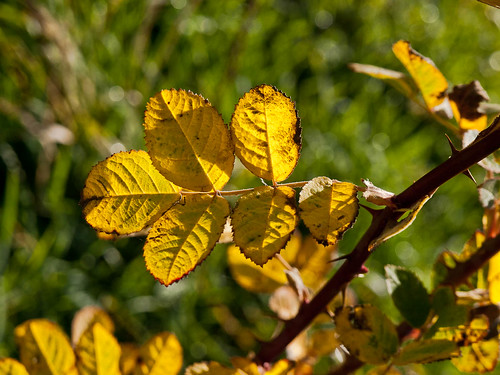
Figure 12: Raindrops on grass. A close-up aiming to capture the raindrops and add to the sense of wetness. This image has bee cropped and rotated for inclusion in the final collage. 1/160 @ f/8; ISO 200; 54mm
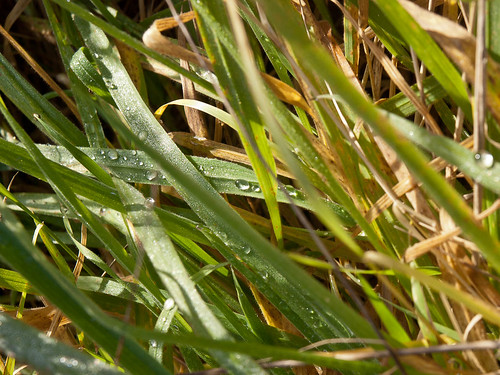
Figure 13: Willowherb. This second vertical format image needed to include a significant amount of sky to avoid the final collage feeling too enclosed. 1/200 @ f/8; ISO 200; 14mm. 1 stop overexposed to provide leaf detail.
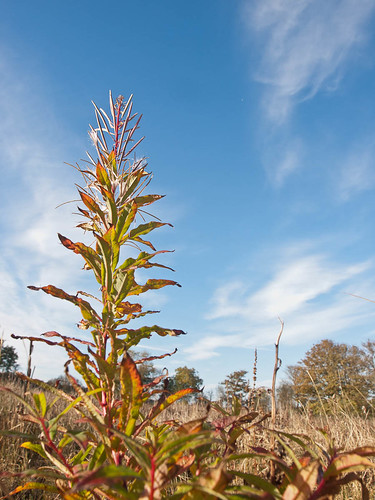
Figure 14: Final Collage for Section 2

A couple of ‘also-rans’
These shots that are not for formal assessment but seem worth including as supporting material to show other aspects I considered in developing my final approach. The first is a multi-shot panorama taken from a little outside the acre. I considered using this as a basis for Project 15 but feel the view does not offer sufficient potential for seasonal variation.
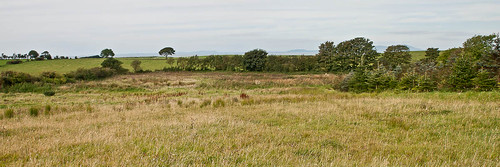
The next is a duplicate of a previous experiment I tried with light trails, trying to capture the idea of the ‘spirit’ of the area. While it has some interest of its own it does not fit in the context of this set.
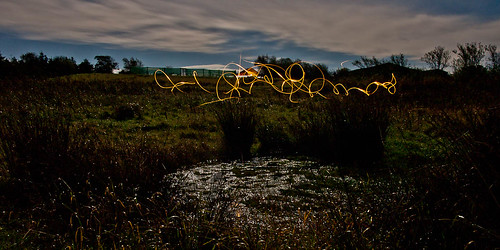
Lessons learned
Concept: This was quite a challenging exercise once I moved past the simple ‘take some photos of somewhere pretty’ reaction which I think is almost conditioned by the course text. What did I want to do? There are two lines of research that currently interest me – one about perspective, space and memory and the other about portrayal of time and seasonal symbolism. Initially I found it hard to resolve which of these to focus on, so initially I simply took some photos to see what emerged. This is perhaps the key lesson for me – sometimes you have to take photos to understand what you are taking. Does this contradict the lesson of Assignment 1? I don’t think so as I started shooting with a clear idea of what I was trying to achieve.
The final resolution was in major part down to the fact that the landscape is so simple that it is almost devoid of seasonal symbolism at this time of year. The autumn leaf (Fig. 11) is the only truly obvious example.
Planning: This was the least difficult part of this assignment – at least as far as shooting went. I have continuous easy access to the site. The owners are used to seeing me so, demands of work permitting, I could choose when and what to photograph.
Assembling the final collection was somewhat more difficult as I had to sift through the images with an eye to the potential crops I would need for particular parts of the collage. The key lesson here is that by having an idea of how I wished to present the images I could ensure I had enough options for the final output.
Research: You will see from my blog that I have put quite a bit of effort into studying perspective (albeit in the context of Japanese art in some cases), and into seasonal symbolism in a culture which I perceive is more connected to the seasons than our own. I think is too early to say that the latter has significantly affected this Assignment (the autumn leaf is touch obvious I this respect) - I expect greater impact on the end of course portfolio. Perhaps more importantly, Fox & Caruana opened my eyes to the idea that photography itself can be research and this is one of the first times (if not the first) that I have consciously used it in that way.
Assessment criteria
Technical and Visual Skills: Once again I find this difficult to assess. I think I have produced a range of images from close-up to distant landscape, of a range of subject matter, in a technically competent way. I made much more use of a tripod in these images (not just the night images), and I believe these samples show that I can produce technically sound images in difficult lighting conditions including moonlight and contre jour lighting.
I believe I have avoided a simple pictorial approach – I have tried to be honest about the area itself
Quality of Outcome: Given that the aim of the assignment (beyond the stated one) was to explore different ways of portraying space I believe this is a good start to a study which I expect to revisit on a regular basis.
Creativity: In looking beyond traditional flat presentation of a set of images I believe I have taken a creative approach to addressing one of the limitations (in a purely physical sense) of photography in producing a sense of place. It is certainly the first time that I have considered displaying photographs as an installation that allows physical interaction with the viewer.
Context: I have tried to place the two sections of this assignment into the context of some current thoughts on portrayal of perspective and the workings of memory. In doing so I have gone outside simple photographic literature by picking up on the work of David Hockney alongside more conventional photographic practice.
Links and references
Land Matters: Liz Wells – recommended course text which emphasises the potential of Landscape to convey messages.
A Bigger Message: Conversations with David Hockney: Martin Gayford – a series of interviews/recollections of conversation with David Hockney
Behind the Image: Anna Fox and Natasha Caruana – recommended course text on research in photography
Mikkel McAlinden: http://www.mikkelmcalinden.com/: Images 1,2 and 13-16 on the ground floor of the virtual gallery inspired my proposed display of the first 4 images.
World Kigo Database – a database of seasonal words for Haiku writers that provides a lot of inspiration for seasonal imagery.
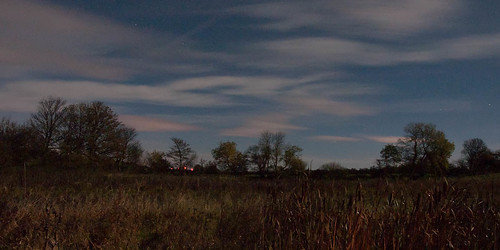

No comments:
Post a Comment